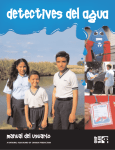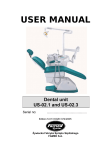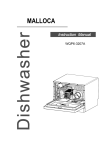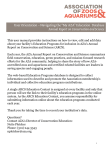Download USER'S GUIDE - Office national du film du Canada
Transcript
Water Detectives USER’S GUIDE A NATIONAL FILM BOARD OF CANADA PRODUCTION WATER DETECTIVES USER’S GUIDE Contents 1. Introduction ...................................................................1 2. Filmmakers’ Comments .........................................................2 3. About this DVD and User’s Guide . . . . . . . . . . . . . . . . . . . . . . . . . . . . . . . . . . . . . . . . . . . . . . . . . 2 4. Who appears in the documentary ................................................3 5. Materials Needed . . . . . . . . . . . . . . . . . . . . . . . . . . . . . . . . . . . . . . . . . . . . . . . . . . . . . . . . . . . . . . . 4 6. Suggested Discussion Questions . . . . . . . . . . . . . . . . . . . . . . . . . . . . . . . . . . . . . . . . . . . . . . . . . . 4 7. Suggested Classroom Activities ...................................................7 8. Internet Resources .............................................................8 9. Suggested Reading .............................................................9 10. Supplementary NFB Resources . . . . . . . . . . . . . . . . . . . . . . . . . . . . . . . . . . . . . . . . . . . . . . . . . 10 Appendix A: Cloze sheet and Answer Key . . . . . . . . . . . . . . . . . . . . . . . . . . . . . . . . . . . . . . . . . . . 11 Introduction “For me it’s important, because like all children and youth in my community, we all want to live in a world with water,” says Mariana Dominguez, age 12, a “water detective.” This short documentary looks at the importance of water in our lives through the lens of some children in one Mexican town. It asks, How do we learn to value something most of us take for granted? The film suggests that starting at the community level and empowering children to plant the seeds of social change is one way. The project profiled in Water Detectives originated in the water department of the city of Matamoros, Mexico, but its message is global. The need to know where our water comes from and how to use it wisely is as important in Victoria, B.C. as it is in hot, dry, towns like Matamoros. The biggest challenge, as the children in the film point out, is to change our attitudes about this essential resource. Learning how to conserve water and educating ourselves about the sources of water for our communities are two ways. Capable and confident, the three children in the film show us where their water comes from and how their city’s water system works. Becoming water detectives has been a big step forward for the children of Matamoros. The film is aimed primarily at children from Grades 4 to 7 and has voiceovers in English for the Spanish dialogue and is subtitled in French. 1 Filmmakers’ comments Water Detectives for us underlines how we in the North can learn from countries in the South. Matamoros is not an affluent city by any means, but as the film shows, you don’t need a lot of resources – but instead – lots of imagination, creativity, humour and the energy of children to help change attitudes. The energetic and knowledgeable children in the film show us how they’re doing it. The film is not meant to be a template for Canadian schools. Cultural differences and the nature of neighbourhoods and schools will determine what is appropriate for different ages and places. The challenge is: What can we learn from these people in this place and apply it to our communities at home? As the earth’s climate continues to change and as populations grow – especially in cities – putting more and more pressure on all our resources, the narrator’s opening words about water – “without it, nothing can live” are ones to remember. David Springbett, Director Heather MacAndrew, Writer About this DVD and User’s Guide Water Detectives is available in French- and Spanish-language versions. Running time is 11 minutes and 30 s. This DVD is appropriate for children in Grades 4 – 7 and is suitable for the following subjects: Science (Life Science) and Social Studies (Application of Social Studies and Environment) where students are expected to: Grade 4: determine how personal choices and actions have environmental consequences; design and implement strategies to address school problems or projects. Grade 5: describe the diverse distribution of natural resources within Canada; demonstrate understanding of sustainability, stewardship and renewable versus non-renewable natural resources; assess effects of lifestyles and industries on local and global environments. Grade 7: analyze the roles of organisms as part of interconnected food webs, populations, communities and ecosystems; evaluate human impacts on local ecosystems. This guide was written by Heather MacAndrew, in consultation with Susan S. Almeida and Holly Keon. 2 Who appears in the documentary? Three children from two schools in Matamoros “star” in the documentary: Mariana Dominguez, age 12; Carlos Garcia, age 9; Raul Garcia, age 14. Also appearing are the cartoon characters Super Gotico (Super Water Drop), his sidekick Quique, and Don Gaston Aguado, the bad guy. The voiceover translations and narration are read by non-professional Canadian children from Victoria, B.C. Mariana was the city’s “top” water detective in 2005. She represented the state of Tamaulipas at the 2006 International Water Forum in Mexico City. Carlos Garcia was the top water detective in 2004 when he was only 7. As part of the honour he was made “head” of the city’s water department for one day. 3 Materials Needed Go to http://images.google.com/imghp to download the following maps: • • • • • Rio Grande Watershed Rio Bravo/Rio Grande (same river, two names that empties into the Gulf of Mexico) Gulf of Mexico Matamoros, Tamoulipas (Mexico) Brownsville, Texas (USA) Suggested Discussion Questions 1. Why does the river in the film, the Rio Bravo, have two different names? (It is located between two countries, the U.S.A. and Mexico. In Mexico they call it Rio Bravo and in the U.S.A. they refer to the river as the Rio Grande.) 2. The film says the Rio Bravo starts high up in the Rocky Mountains and passes through several American and Mexican states before it flows into the Gulf of Mexico. Can you find the Rio Grande/Rio Bravo on a map and make a list of the American and Mexican states? Also, locate Matamoros, Brownsville (Texas) and the Gulf of Mexico. (The Rio Bravo starts in the American state of Colorado, then moves into the state of New Mexico, next into Texas and then flows along the border of Mexico and U.S.A. In Mexico it flows past the states of Chihuahua, then Coahuila, then into Nuevo Leon, finally ending in the state of Tamaulipas.) 3. Look at a map of your province and trace the major rivers and where they flow. Are any of these rivers near your town? Does your town get its water from a river? (Answers will vary. In British Columbia, the Fraser River flows into the Pacific Ocean.) 4. Do you know where the water for your city or town comes from? Do any of you depend on ground water from wells? Have you ever visited a place or stayed some where where you relied on ground water from wells? (If students live in or near Canadian major cities, they will not rely on ground water from wells; however, there are many rural families that depend on ground water in wells. Perhaps students have visited these areas.) 5. What is a water shed? Does every community have one? Where is yours? (A water shed is a drainage basin, i.e., an area of land that drains into a particular lake, river, stream, or wetland. Not every community will have one.) 4 6. What is a reservoir? Does your community have one? What is the source of the reservoir’s water? (A reservoir is a lake or tank for storing a substantial supply of water for human consumption or agricultural use. Vancouver has the Little Mountain Reservoir owned and operated by the Greater Vancouver Regional District and holds the city’s drinking water supply. Most of the water in the reservoir comes from rain and snow.) 7. How much rain does your town get in a year? What if there weren’t any rain – how would that affect your town’s water supply? (Answers will vary. Vancouver is popularly known as a rainy city. On average 166 days per year have measurable precipitation, and 289 days have measurable sunshine. Still, from November until March, it is not uncommon to have 20 consecutive days with some amount of rain. If there was no rain, there would need to be serious water restrictions to conserve water. It would be for drinking and for everyday needs: toilets, showers, washing, etc.) 8. Do you know what gray water is and how it works? Is this a good idea? Explain. What are some obstacles in trying to recycle gray water? (The head office of the Body Shop near Toronto, Ontario, recycles its gray water. A class project might include researching the web about the design of this building and calling the company’s Operations Manager to find out if there are any drawbacks to using gray water.) (Any water that has been used in the home, except water from toilets, is called gray water. Dish, shower, sink and laundry water comprise 50-80% of residential “waste” water. This may be reused for other purposes, especially landscape irrigation. The benefits of gray water recycling include: lower fresh water use, less strain on failing septic tank or treatment plant; gray water treatment in topsoil is highly effective, ability to build in areas unsuitable for conventional treatment, less energy and chemical use, groundwater recharge, plant growth and reclamation of otherwise wasted nutrients.) 9. In places where it’s hot and dry in the summer, people are discouraged or perhaps banned from watering their lawns. Is this a good idea? Are lawns a good idea? Do you know what xeriscaping is? Is it a good alternative to grass lawns? (Answers will vary. Xeriscaping refers to “Landscape architecture”, landscaping that doesn’t require supplemental irrigation. It is promoted in areas that do not have easily accessible supplies of fresh water. Plants whose natural requirements are appropriate to the local climate are emphasized, and care is taken to avoid losing water to evaporation and run-off. Xeriscaping is not the same as “natural landscaping” or “zero-scaping.” Some common plants used in xeriscaping are agave, cactus, lavender, juniper, sedum and thyme. Source: www.wikipedia.com) 5 10. Do some people use rain barrels in your neighbourhood? Can you explain how they work? (Rain barrels collect water that can then be used later on for everyday use.) 11. Many people in the world have to boil their water before drinking it, and sometimes we have to do this when camping or travelling. Why? How is it that bacteria can grow in water and spread diseases? Can you name some diseases spread by impure water? (Boiling kills many water-spread diseases. Some examples are cryptosporidium infection, E. coli, giardia infection, hemolytic uremic syndrome, hepatitis A, salmonella, toxoplasma, cholera, typhoid fever, malaria, botulism, polio and dysentery. One of the first symptoms of these diseases is diarrhea, which causes about three million deaths per year throughout the world, mainly in India, Africa and South America.) 12. Who is in charge of water in your town? Do ordinary people have a say? Do children? How can children make their ideas heard? (Answers will vary. The Greater Vancouver Regional District is in charge of the water supply for the Lower Mainland region of British Columbia. At this time the general public and children do not have a say in the water situation, but that could change.) 13. It is estimated that the human body is 60% water. Discuss. (Water is an essential nutrient that regulates body temperature, transports oxygen and nutrients to cells, cushions joints and protects organs and tissues. The human body is more than 60% water! How much is enough? Drinking plenty of water helps your body get rid of harmful toxins. Without enough water, people quickly become fatigued. Nearly every function of the human body requires water!) 14. Should water be sold? Do you use bottled water? Is bottled water a good idea or not? Discuss. 15. Some people say Canada should sell their water to the United States. Discuss. 16. What things do you like about the Water Detectives project? What don’t you like? 6 Suggested Classroom Activities Activity 1: Go through your day, from morning till bedtime, and make a list of all the times you use water, either by turning on a tap or fountain for a drink, to cooking, to showering, to flushing the toilet. Try to estimate how much water – in litres – you might use in an average day. Now try to imagine if there was a water shortage in your town and you had to reduce your consumption by half. How would you do this? Activity 2: Walk through the school and school yard with pens and notebooks and make a list of all the places where water is used and why. Discuss how school would be different without a good water supply. Activity 3: Make a list of ways we tend to use water carelessly – and alternative ways of doing things. For example, in the film, Mariana stops to talk to a neighbour about using a hose to wash her car. What’s wrong with using a hose? Is there a better way? Activity 4: Arrange a field trip to your town’s water treatment plant with a water department person as your guide. On another day, go and visit a reservoir if your town has one. Activity 5: Make a list of the ways buildings are starting to conserve water. For example, have you noticed taps that go on with a motion sensor and off after a few seconds? What does this do? Have you heard of low flush toilets or people who put sand-filled bottles in their toilet tanks? What does this do? Can you list other ways that people are trying to conserve water? Activity 6: Discuss the different forms of water (ice, snow, liquid). How does the water cycle work? Try an experiment in evaporation and melting. How long does it take an average ice cube to melt? Activity 7: Discuss how a Water Detectives project might work in your school and neighbourhood. What parts of it might not be appropriate? How could the general idea be adapted or changed to work in your school and town? Discuss what would have to be organized and presented (to the school, to the municipal council etc.) to make it happen. 7 Internet Resources Environment Canada: Let’s not take water for granted www.ec.gc.ca/water/en/info/pubs/e_teach.htm This Web site offers teaching suggestions, reading material and learning activities for Grades 5-7. Refer to the information from A Primer on Fresh Water and the Water Fact Sheets. The Children’s Water Education Council www.cwec.ca Children’s Water Education Council members benefit from the larger groups experience and expertise in educating children about water issues. The Council promotes water guardianship by teaching children to take responsibility for water conservation and pollution prevention. Includes how to host a Children’s Water Festival in your community. U.S. Geological Survey’s Water Science for Schools ga.water.usgs.gov/edu/ This American site offers child-friendly information, along with pictures, data, maps and an interactive centre where you can give opinions and test your water knowledge. Mostly English and Spanish. U.S. Environmental Protection Agency: Water www.epa.gov/water/kids.html This site offers great ideas for kids on water conservation and environmental protection (through projects, art and experiments). Seminole County, Florida: Kid’s Corner www.seminolecountyfl.gov/envsrvs/watercon/kidscorner.asp This site offers great ideas for kids on water conservation (interactive games and online activities). Urban Programs Resource Network www.urbanext.uiuc.edu/world/ This site for kids is about global warming and nature's response, the effects of acid rain and the depletion of natural resources (including water). 8 Suggested Reading Many children’s books on water have been written over the years. Some focus on the science of water; some on environmental considerations; others on a global survey; others on how we use water in our daily lives, including how plumbing works! Some of the newer books look at current topics such as whether or not water should be sold. Some of the older books are still valuable for their science content. Water Detectives is about water conservation and how children can help conserve water every day, but teachers may want to use the film as a jumping off point to explore other issues. Here is a list of books for primary and senior elementary. For Primary Grades: Water by Kim Taylor; Wiley & Sons, 1992. Water by Penelope Arlon, DK Publishing, 2006. Water at Work (how we use water) by Barbara Taylor, Franklin Watts Inc., 1991. The Wonder of Water by Diane Swanson, Annick Press, 2005. Wonderful Water by Bobbie Kalman and Janine Schaub, Crabtree Publishing, 1992. World of Water, Essential to Life (what makes water so special?) by Rona Arato, Crabtree Publishing, 2005. For Senior Elementary: The Amazing Water Book by Deborah Seed, Kids Can Press, 1992. Designs in Science – Water by Sally and Adrian Morgan, Evans Bros. Ltd., 1994. A Drop of Water by Walter Wick, Scholastic Press, 1997. (This book has remarkable photos and could also be used with younger children.) Food and Water: Threats, Shortages and Solutions by Jenny Tesar, Facts on File, 1992. Water (a global look) by Pamela Grant and Arthur Haswell, Thameside Press/Belitha Press, 2000. Water for All by Sally Morgan, Franklin Watts (Earth Watch), 2000. Water, Our Precious Resource (a global look) by Roy A. Gallant, Benchmark Books, Marshall Lavendish, 2003. 9 Supplementary NFB Resources Available in French and English: Animania: Season Two – Episode 10 (1999, NFB) A fairy tale in the modern manner, told without words by film artist Norman McLaren. Divine Fate tells of a mythical universe whose existence is threatened by the arrival of unthinking and uncaring visitors. A cautionary tale with a pro-environmental theme, it is a metaphor for our times. Planet Earth: Caring for our Environment (1994, NFB) A compilation of three children's videos about the environment: Lord of the Sky; Paradise Lost; and Journey of the Blob: The water cycle is illustrated while raising many questions about environmental responsibility and the consequences of our decisions. Latin America: The Thirsty Cities (1993, NFB) Thirsty Cities looks at the problems related to water supply in Mexico City, Lima, Buenos Aires and Sao Paulo--conservation, pollution and sanitation. Earth, Wind and Water (1987, NFB) The four titles in this compilation deal with water. Titles include: Estuary; The Rise and Fall of the Great; S.P.L.A.S.H.: What happens to water from the time it falls as rain until it reaches its destination, and the demands placed on our waterways by agriculture, industry, and urban life; and Gulfstream. Visit www.nfb.ca for additional titles relating to the following categories: Developing Countries: Mexico Environment and Conservation: Water Resources Urbanism Additional guides are available at www.nfb.ca/guides. To order Water Detectives or other NFB titles: Shop online: www.nfb.ca/store or In Canada, call toll-free: 1-800-267-7710 In USA, call toll-free: 1-800-542-2164 International, call: 514-283-2703 In the Montreal area, 514-283-7564 Monday to Friday, 9 am – 7 pm 10 Appendix 1: Cloze sheet and answer key 1. Water is life. Without it, nothing can ____________. 2. The Rio Bravo begins high in the ____________ ____________ , thousands of kilometres away. 3. The river starts in the state of ____________ and passes through ____________ of the U.S. states and ____________ of the Mexican states. 4. ____________, Mexico is the last city to use the water from the river. 5. Once the water is pumped from the river into the station, it is pushed into a ____________. 6. There are ____________reservoirs in the city of Matamoros. 7. The river has gone dry once before on ____________ and the people of the city do not want to see that happen again. 8. The water detectives we meet in the film are: ____________, ____________, and ____________. 9. The water detectives take care and have an appreciation of ____________. 10. They promote the detectives in their community and give presentations about how to take care of water so all the ____________ can join the group. 11. The water detectives check streets and homes for ____________. 12. Adults in the city say that they have learned a lot from the____________ ____________. 13. Besides creating the Water Detectives project, the city of Matamoros has also created “Superheroes” to help teach younger children about the importance of water. We meet: Super Gotico ____________, ____________ Quique ____________ Don Gaston Aquado ____________, ____________ 14. Right now the Rio Bravo is maintaining the same flow, but every year, little by little, the Rio Bravo is ____________ more and more. 15. In 2004, Matamoros used ____________ less water than in 2003. 11 Answer Key 1. live 2. Rocky Mountains 3. Colorado, three, five 4. Matamoros 5. reservoir 6. four 7. July 4, 2000 8. Mariana Dominguez, Carlos Gaspar Garcia, Raul Gaspar Garcia. 9. water 10. children 11. leaks 12. water detectives 13. We meet: Super Gotico – water drop, who conserves water Quique – his sidekick Don Gaston Aguado – bad guy, wastes water 14. diminishing 15. 18% 12 WATER DETECTIVES ________________________________________________________ ________________________________________________________ ________________________________________________________ ________________________________________________________ ________________________________________________________ ________________________________________________________ ________________________________________________________ ________________________________________________________ ________________________________________________________ ________________________________________________________ ________________________________________________________ ________________________________________________________ ________________________________________________________ ________________________________________________________ ________________________________________________________ ________________________________________________________ ________________________________________________________ ________________________________________________________ ________________________________________________________ ________________________________________________________ ________________________________________________________ ________________________________________________________ ________________________________________________________ ________________________________________________________ ________________________________________________________ ________________________________________________________ ________________________________________________________ ________________________________________________________ ________________________________________________________ ________________________________________________________


























